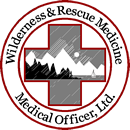Risk-Benefit in Rescue
©2024 Jeffrey E Isaac, PA-C
When introducing wilderness medicine to a new group of students, one of my favorite lead-in stories concerns the rescue of an injured crewman from a yacht on passage from Bermuda to New England many years ago. The man was struck on the head by the boom as the boat rolled in a strong NE wind in the Gulf Stream. The evacuation that followed made for a truely exciting sea story, complete with the nighttime transfer of the patient by rubber dinghy to a fishing vessel and the 200-mile offshore helicopter evac with in-flight refueling. Great reading! One hardly noticed the epilogue, which reported that the lucky crewman was discharged from the hospital after 2 hours with a few stitches in his scalp.
This rescue, as so many of them are, was probably unnecessary. The considerable risk to the patient, crew, and rescuers was unjustified. Unfortunately, this scenario is repeated countless times on a land and sea. Why does this happen?
Two main reasons, really. One, the people in trouble, or the people reporting the trouble are unable to tell the difference between a true emergency and a logistical dilemma. With medical problems, we’ve been trained to defer judgment to physicians and other medical professionals. Ashore in town, you don’t have to know any more about medicine than the numbers 911. To go out to sea or into any other wilderness requires a much greater degree of personal responsibility.
The other problem stems from the rescuers themselves. Search and rescue work is often arduous, technically demanding, and almost always dangerous. But, the professionals and volunteers who provide this service love their work. Most units train relentlessly and have lots of expensive equipment and are eager to use it. They will willingly put themselves in danger to help you out. Sometimes the wisdom or actual necessity of the mission is given little consideration. If it sounds bad they go. It takes a very disciplined mission commander to delay or call off a rescue based on an unfavorable risk: benefit ratio.
This places a tremendous responsibility on you when calling for help. Does the benefit of the help you’re asking for substantially outweigh the risk to you, your crew, and the rescuers who will come to your aid? Is your crewman seriously injured, or just uncomfortable and scary looking? Is your vessel really in danger, or are you just tired and seasick? These can be tough questions in a difficult situation.
You may not have to answer these questions alone, however. Well-rehearsed communication skills become critical in an emergency at sea. Presenting a clear picture of the situation will allow rescuers to best apply their local knowledge, experience, and resources to helping you make the right call. Avoid panic requests such as “Oh my God, its really bad, come quick!” These provide no useful information and only serve to distract people from a good planning process. Your job, especially as skipper or medical officer, is to always be thinking objectively about the risk: benefit ratio.
Of course, the risk involved in rescue changes with location, time, and weather. On a nice day in Puget Sound, it makes sense to evacuate a crewmember with a large scalp laceration to the appropriate medical care. The risk of evacuation is low, and the benefit in comfort and timely treatment is worth it. However, put the same patient a couple of hundred miles offshore in a storm, and the ratio is totally reversed. Having enough knowledge and experience to be able make this judgment is a good goal for your training and emergency drill program. At sea, as in the mountains, it is just as important to know when you don’t have an emergency as when you do.

